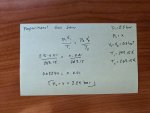BUT this is the surrounding air temp when you test your tyres with the tyres at the same temp as the air...so if you are testing your tyres inside the garage its that temp..not the temp outside the garage...
OK so here you are saying when you set your tire pressure inside a warm garage, to set it higher than normal if its cold out...
So if you are setting the pressure outside in the cold, early morning... then you would agree to just set it at the normal recommended pressure, right?
Thats not what you are saying here however....?
Regarding altering the tyre pressure...DON'T!!
The tyre pressures for the cars are quoted nominally at 20C......when the temp drops to 0C the same tyre should be 0.1bar less..DO NOT inflate the tyre to the normal setting as when the tyre warms up through use it will be over inflated!!
so if 2bar at 20C...then set to 1.9bar at 0C....& 1.8bar at -10C....& 1.7 bar at -20C...that is the correct inflation !!
It seems you are suggesting to set you tire pressure lower during cold weather because it will over inflate when it reaches operating temperature......?
Thats the first time i hear that... This is usually the way to go:
Yes, also wait till you get the first cold day that hits your average winter temp and adjust tire temps then, once.
From what i understand, outside temperature doesn't matter* as long as the pressure is correct... in fact, better heat dissipation in colder weather leads to lower than desired operating tire temperature and thus lower tire pressures when driving.... if anything, manufactures recommend higher pressures for winter tires, for that reason and the softer compounds....
*(not taking into consideration rubber compounds, winter tires, etc)
